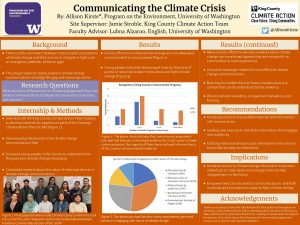Communicating the Climate Crisis: Assessing the Role of Rhetoric in Climate Change Communication
Though more information is readily available and accessible regarding climate change disasters, we do not see a proportional response of behavior changes to mitigate such disasters. This study aimed to better understand the role of rhetoric in climate change communications, as well as explore what other factors informed whether climate change communications would be effective or inspire action in their audiences. To answer this question, I drew on experience that I received as an intern with the King County Climate Action Team, where I was responsible for aiding in communications strategy to build support for the Strategic Climate Action Plan. Additionally, I conducted a survey amongst young people to better understand how they perceived their roles as audience members in climate change communications. Lastly, I interviewed professionals in the climate change communications field to better understand the ways that their strategies or methods differed. The main takeaways that I derived from this research and internship were that most audiences respond better to personal stories or situations in which they can understand the direct impact that an issue has on them, which can be achieved through metaphor, imagery, and framing. Additionally, I learned that, more important than any specific rhetorical device was finding a communicator that the community could trust. The biggest implication of this work is this idea that community leaders are trusted as communicators and hold the rhetorical tools and connections necessary to meaningfully engage an audience.
